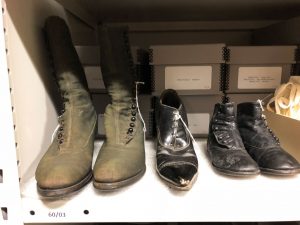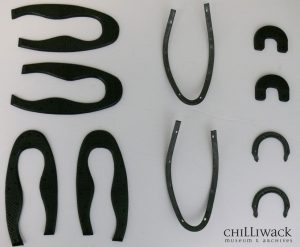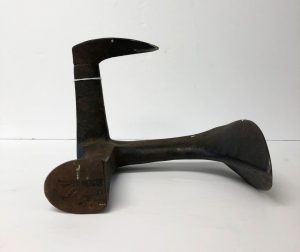The idea of repairing something can oftentimes take a backseat to purchasing a new item. Stores lined with new, shiny gadgets and niceties designed to make our lives easier often win out over rolling up our sleeves and fixing what we already own.

Selection of women’s and children’s footwear from the Chilliwack Museum and Archives collection [Photo credit: Anna Irwin]
Buying new items when a problem occurs with an older object hasn’t always been the first instinct. Got a shoe separating from its sole? Today, we might head to Wellington Avenue, to one of the malls or look for a new pair online to see if something that might catch our eye. In the late 19th century and throughout the 20th century, however, purchasing a new pair of shoes was often a considerable investment for families, especially families with young children. Visiting a local cobbler or shoe store offering repair services, such as E.O. Wickham’s or A.E. Wiltshire Shoe Repair, could often extend the life of a pair of shoes, sometimes for decades depending on the level of care and maintenance paid to a pair of shoes and the material composition of the shoe.

Shoe Repair Kit donated by John Groves containing sole and heel menders. [Chilliwack Museum and Archives, 1977.028.025.1a-d]
Re-soling or adding soles to shoes was (and continues to be, although much less common) one way of making shoes last longer. Sole and heel menders, such as the ones found in a Shoe Repair Kit donated to the Chilliwack Museum and Archives, could be attached to the underside of the shoe and were typically affixed with nails.
While driving nails into ones shoes may no longer be common outside of the cobbling profession, modern adhesives such as Shoe Goo allow for young and old alike to fully re-tread well-worn footwear, re-attach separating soles and fill holes at their convenience without use of a hammer or specialized tools.

Boot last featuring three forms – one for men, women’s & children’s shoes. [Chilliwack Museum and Archives, 2002.003.001; Photo credit: Anna Irwin]
Shoe lasts were and continue to play a key role in the manufacture and repair of footwear. Traditionally made from wood or metal, shoe lasts are foot-shaped inserts used by cobblers to form and fill-out shoes while not being worn by a person. Shoe lasts come in a wide variety of shapes and sizes to accommodate the different styles of feet and the different types of shoes people wear. They can be used as a base around which to craft a shoe or as a form to hold the shoe’s shape whilst being repaired. Shoe lasts are different than shoe trees or shoe stretchers, which are used more frequently to hold or expand the shoe’s shape when not being worn.
At the Chilliwack Museum and Archives, we are proud to house a variety of artifacts that have been donated by the community, including examples of historic footwear and tools used to make and mend shoes and boots of all shapes and sizes. To donate to our object collection, please feel free to contact me by email at anna@chilliwackmuseum.ca or by phone at 604-795-5210 ext. 105.

Comments are closed.